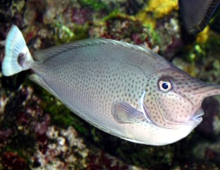Description: Juvenile and adult Unicorn tangs differ in appearance. As juveniles, they are oval in shape and a light green-grayish color. They have bright turquoise blue stripes running longitudinally along their dorsal and anal fins. As they age, their body becomes a long, bullet-like shape and their color is more grayish with blue hues. Their skin is smooth; lips are light blue; dorsal and anal fins are thinly edged with blue; and the caudal fin develops streamers. There are two blue plates bearing knife-like spines on either side of the caudal peduncle (the narrow part of the body where the tail attaches). These tangs develop their single, bony horn that projects from their head when they reach approximately six inches (15 cm) in length.
Size: Adults can reach maximum lengths of 27 inches (70 cm).
Behavior: Unicorn tangs use their two fixed “scalpels” located on either side of the caudal peduncle to defend themselves and their territory. In this species the “scalpels” are noticeable because they are blue. They are diurnal and usually occur in small groups or pairs.
Diet: They feed mainly on algae and plankton.
Communication: To entice females to spawn, males perform a shimmering movement and their colors become more brilliant.
Reproduction: Like other tangs, Unicorn tangs reproduce externally. The female and male swim
upward through the water releasing gametes as they go; fertilization takes place in the open water. The fertilized eggs are pelagic.
Habitat/range: Naso unicornis inhabit inshore coral reefs from the Red Sea and East Africa to Hawaii, northward to southern Japan and southward to New South Wales and Lord Howe Island.
Status: Listed as Least Concern on IUCN Red List.



